 Edit article
Edit articleSeries
What Was Life like in Biblical Times?

Man dressed in period clothes rolls dough with a rolling pin. Nazareth Village, Israel. December 16, 2016. 123rf
To some extent, we can learn about life in biblical times by combing the biblical text, but our ability to extract reliable data from the biblical text alone is hampered by a number of problems.
First, the Bible does not always give a clear answer, either because we no longer understand certain terms,[1] or because textual variants say different things, or because of different biblical passages written by different authors offer contradictory information.
Second and more broadly, the Hebrew Bible is mainly interested in recalling key events and the roles that certain personalities (e.g. kings and prophets) played in them. Even putting aside the question of historical accuracy, this introduces biases into our picture of life, since it inevitably focuses on the elites or information of interest to elites.
In other words, the main concern of the scribes who authored the biblical texts is with the upper class, while the average man and woman are, for the most part, left out. Thus, from the text, we get a certain picture of what life might have been like in the cities such as Jerusalem, Samaria, or Lachish, but not what was going on in the small towns and villages where most of the population resided.
This situation can be remedied by archaeological work and the analysis of finds related to everyday life. Today, this type of work is referred to as “household archaeology.” Using the latter approach, we can learn about the socio-economic conditions of the majority of inhabitants of the land in these times. With the help of archaeology, we can find out what actually was going on in their life. Let’s look at food production, including the shepherding/farming dichotomy, as an example.[2]
Nomadic Shepherds in Genesis
Early on in the Bible, we are confronted by a story that depicts a sharp contrast between two lifestyles: the farmer and the shepherd:
בראשית ד:ב …וַיְהִי הֶבֶל רֹעֵה צֹאן וְקַיִן הָיָה עֹבֵד אֲדָמָה.
Gen 4:2 …Abel became a keeper of sheep, and Cain became a tiller of the soil.
In this case, the farmer Cain murders his brother Abel, the shepherd, which implies that the author favored shepherding over farming. This fits with the fact that Genesis continues with the stories of the patriarchs, all of whom are depicted as shepherds living in tents and herding their flocks.
In light of this, scholars and lay people long assumed that the Israelites began as shepherds, and imagined something akin to the Bedouin life-style as seen in the Levant in the 19th and early 20th centuries. Early scholars would thus speak of a Bronze Age, early-Israelite patriarchal period characterized by nomadism. Nevertheless, this goes beyond the evidence in a number of respects.
First, we do not know whether the stories about the patriarchs are based on historical personages, and if so, when they lived. Second, even if it is based on real people or a real lifestyle, the periodization of these people as “patriarchs,” i.e., biological ancestors of the Israelites living in an earlier period, is likely artificial.
Therefore, it is hard to say that the nomadic lifestyle of the patriarchs is a depiction of a particular period in Israelite history. If anything, it is a reflection of a certain lifestyle prevalent in the ancient Near East that existed among the Israelites, and that has lasted even to the modern period under certain conditions.
Tent-Dwelling Nomads
That segments of Israelite society lived in tents is well documented in Jeremiah 35, set in the late 7th early 6th centuries B.C.E. It describes the Sons of Rechab as tent-dwellers (35:7) and idealizes this way of life:
ירמיה לה:ו וַיֹּאמְרוּ לֹא נִשְׁתֶּה יָּיִן כִּי יוֹנָדָב בֶּן רֵכָב אָבִינוּ צִוָּה עָלֵינוּ לֵאמֹר לֹא תִשְׁתּוּ יַיִן אַתֶּם וּבְנֵיכֶם עַד עוֹלָם. לה:ז וּבַיִת לֹא תִבְנוּ וְזֶרַע לֹא תִזְרָעוּ וְכֶרֶם לֹא תִטָּעוּ וְלֹא יִהְיֶה לָכֶם כִּי בָּאֳהָלִים תֵּשְׁבוּ כָּל יְמֵיכֶם לְמַעַן תִּחְיוּ יָמִים רַבִּים עַל פְּנֵי הָאֲדָמָה אֲשֶׁר אַתֶּם גָּרִים שָׁם.
Jer 35:6 They replied, “We will not drink wine, for our ancestor, Jonadab son of Rechab, commanded us: ‘You shall never drink wine, either you or your children. 35:7 Nor shall you build houses or sow fields or plant vineyards, nor shall you own such things; but you shall live in tents all your days, so that you may live long upon the land where you sojourn.’…”
The lifestyle of a nomadic shepherd could be quite difficult, as Jacob says in his rant to Laban:
בראשית לא:לח זֶה עֶשְׂרִים שָׁנָה אָנֹכִי עִמָּךְ רְחֵלֶיךָ וְעִזֶּיךָ לֹא שִׁכֵּלוּ וְאֵילֵי צֹאנְךָ לֹא אָכָלְתִּי. לא:לט טְרֵפָה לֹא הֵבֵאתִי אֵלֶיךָ אָנֹכִי אֲחַטֶּנָּה מִיָּדִי תְּבַקְשֶׁנָּה גְּנֻבְתִי יוֹם וּגְנֻבְתִי לָיְלָה. לא:מ הָיִיתִי בַיּוֹם אֲכָלַנִי חֹרֶב וְקֶרַח בַּלָּיְלָה וַתִּדַּד שְׁנָתִי מֵעֵינָי.
Gen 31:38 These twenty years I have spent in your service, your ewes and she-goats never miscarried, nor did I feast on rams from your flock. 31:39 That which was torn by beasts I never brought to you; I myself made good the loss; you exacted it of me, whether snatched by day or snatched by night. 31:40 Often, scorching heat ravaged me by day and frost by night; and sleep fled from my eyes.
We also learn from the stories of Rebekah and Rachel that young girls would be placed in charge of the herds, a practice that remained common among Bedouins into modern times.[3]
Nomadic, Transhumant, and Sedentary Shepherds
Yet not all tent-dwelling shepherds were nomadic; instead, they should be subdivided into two types: nomadic and transhumant. Nomadic shepherds do not live in one set place; they have no set “home” but travel a circuit along with their flocks following seasonal growth. Transhumant shepherds also travel with their flocks, but they have a home base to which they return when they can, often maintaining a social and trade relationship with a given village, where people lived year-round.
How prevalent either of these lifestyles may have been in the biblical period is difficult to know, as no known actual remains give us quantifiable data for herders in this period. In any event, tent-dwelling shepherds are difficult to find in the archaeological record. More common would have been sedentary shepherds, i.e., villagers who maintained small flocks, including cattle for plowing and pulling carts[4] (wandering shepherds do not generally keep cattle)—these differ from both nomadic and transhumant shepherds.
Village Life
The archaeological evidence concerning village life is quite extensive. Starting in the period of the settlement, ancient Israelites lived in small villages dotting the hill country and occupied by family units. The villages were built in a circle, a design that provided security for the inhabitants and their domestic animals.
Village life continued in the monarchic period, but at the same time, towns and cities began to appear as well. Small villages (or farmsteads) remained unfortified and continued in their circular design. In contrast, cities and even towns were fortified, and in many of them, houses were built adjacent to and as part of the city wall.[5] (Remember Rahab living in the wall? [Josh 2:15]).
Houses
Both rural and urban settlements made use of a new house-type that was introduced in the settlement period and solidified in the monarchic period. The style house is known in scholarship as the “Four-Room House” or “Pillared-Courtyard House,” terms that relate to the recovered floor plan or to the construction method, respectively.[6]
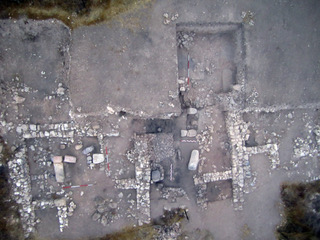
|
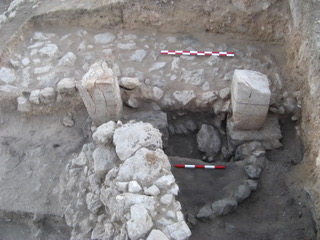
|
The four-room designation describes the design of the ground floor of the house remains, which had one broad room in the back, and three long rooms perpendicular to the broad room, the middle of which possibly served as a courtyard.[7] The pillared-house designation describes the fact that most of these houses, which had upper stories, had pillars each made of one large cut stone or a stack of cut or field stones, that provided support for upper stories.
Archaeological remains provide information related to the daily activities that took place especially on the ground floor. These include food preparation, textile production, tool production and repair, storage of commodities, sheltering animals, and more. Activities took place in certain areas of the house which could change depending on the season and needs. Most houses would have had an upstairs as well, accessible by ladder, which was likely where the family members slept.
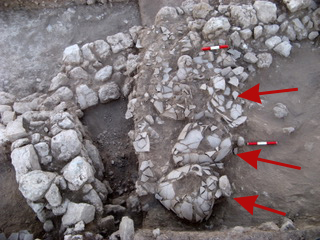
|

|
Village Economy
During the pre-monarchic period, most Israelites resorted to barter using surplus to get certain commodities. In fact, it was their very ability to produce surpluses that allowed for the formation of the state and monarchy, as such complex forms of government require tax revenue to survive.
During the period of the monarchy, commerce using precious metals for exchange was introduced.[8] This did not bring an end to barter but made it possible to import good from other regions. Thus, imported goods are ubiquitous; they can be found not only in the cities and towns, but even in the villages, indicating that even the rural population was not isolated.
Consumption of Animals
As noted, rural Israelites kept animals (sedentary shepherding), which provided not only milk and meat for nourishment but also by-products such as wool, hair, skin and bone. The most standard herd animals were black goats and fat-tail awassi sheep, the native animals of the region. In addition, sedentary herders also kept cattle, which were used for meat and milk as well as for plowing. (Donkeys were also used for plowing, and for transportation, but not for food.)
Meat
To learn more about which animals were eaten and how they were prepared, zooarchaeologists study the remains of animal bones. Some bones of domestic animals used for food, such as small and large cattle, exhibit cut-marks showing how the animals were dismembered and sometimes can indicate whether butchering was done by professionals or novices.
The age of the animals and the specific parts help determine whether the animals were locally raised or purchased, shedding light on the socio-economic status of the population residing in different sections of a site. In short, wealthier people could afford better cuts, even if this meant purchasing the meat from outside sources. Meat was not consumed on a daily basis but only on special occasions such as festivals or when hosting guests.
Milk
In addition to meat, the female animals provided milk. The Bible refers to Canaan as a land “flowing with milk and honey” (אֶרֶץ זָבַת חָלָב וּדְבָשׁ) twenty times. Milk is also the drink of choice for Yael to serve Sisera, when he appears at her tent parched (Judg 4:19, 5:25). In addition, the biblical text describes several dairy by-products, such as cheese, curds, yogurt, etc., that cannot be recovered in archaeological excavations.[9]
Skin, Hair, and Wool
Animals provided more than food. Animal skins were used to make leather for shoes, belts, containers, etc. Goat hair could be used for weaving tent cloth and sacks while sheep wool would be used for clothing.
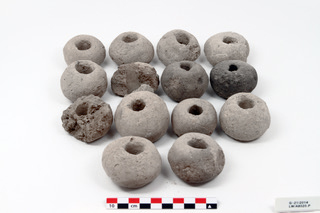
Though it is very rare to find the remnants of clothing or tents, as these objects decompose rather quickly,[10] evidence of textile production comes from the recovery of objects that were used in the process such as spindle whorls (פלך), distaffs (כישור), loom weights (נוּל) and bone spatulas (יתד) all used in weaving.
The finished products were not just for local consumption but for trading. Artistic representations, especially Assyrian, depict what these garments might have looked like. (Extra biblical documents record the fact that garments made in Judah were highly prized by the Assyrians.)[11]
Fish and Fowl
Many in-land sites yielded fish bones originating in various bodies of water including the Mediterranean and the Nile. Numbers 11:5 mentions that the Israelites ate fish in Egypt, and archaeology has recovered fish bones showing that the Israelites ate fish during biblical times in Israel as well.[12]
The Fish Gate of Jerusalem (Zeph 1:1-2,10; Neh 3:3; 12:39; 2 Chr 33:14) indicates that fish were marketed in this inland city. Such fish were likely dried, smoked, or salted.
The list of unclean birds (Lev 11:13-19; Deut 14:12-18) suggests very strongly that the ancient Israelites consumed fowl. Although the domesticated chicken was introduced in ancient Israel toward the end of the Iron Age II, wild birds were hunted using traps and nets (Prov. 6:5; Amos 3:5). Eggs of wild birds were collected for food as well (Deut. 22:6; Isa. 10:14).[13]
Agriculture
Despite the negative depiction of Cain the farmer, and the description of Israel’s patriarchs as nomadic shepherds, rural Israelites engaged in agriculture as their primary occupation. To make the hill country slopes accessible, they made wide use of terracing—although the Bible never mentions this—and plastered cisterns (בור in biblical Hebrew), which allowed them to store water from the rainy season into the dry season.
Agricultural Calendar
The agricultural year is laid out in a document dating to the 10th century, discovered in 1908 at Tel Gezer by R.A.S. Macalister, and known as the Gezer Calendar (translation mine):
|
ירחו אסף |
Two months of ingathering (olives). |
If we think about the year beginning in the spring as the Torah does, the Israelite agricultural cycle began with barley harvest (spring equinox to late April), followed by the harvest of wheat (late April to late May). Grapes were harvested in June and July, other summer fruit in late July to late August, and the ingathering season concluded with two months of olive harvesting (late August to late October).
These seasons are commemorated in particular Israelite festivals. Specifically, Matzot (Unleavened Bread) is celebrated between the barley and wheat harvests,[15] Qatzir (“Harvest”)/Shavuot (“Weeks”)/Bikkurim (“First Produce”) at the end of the wheat harvest, and Sukkot (“Booths”)/Asif (“Ingathering”) between the fruit and olive harvests. Moreover, whereas in the Torah’s spring calendar Sukkot is in the middle of the year, some verses imply that it was once at the beginning, as it is in the Jewish autumn calendar.[16]
Agricultural Products
Agriculture was the Israelites’ main sources of food.
Bread, Wine, and Oil
Bread, made from wheat or barley, was considered the sine qua non of a meal; so much so that the Hebrew word לחם is also a general term for “food.”[17]
Wine (יַיִן or תִּירוֹשׁ) was the most common drink.[18] In fact, wine was so identified with the southern Levant, that the Ancient Greek (οἴνου), Latin (vino), and eventually English words for wine are all derivative of the West Semitic yēn/yayin. The Bible also makes repeated reference to shekhar (שֵׁכָר), probably “beer,” from which we can deduce that this was also produced and consumed.[19]
A third important product was olive oil (יִצְהָר), which was used in preparing different foods and was also used for lighting oil lamps, for medicinal and cultic purposes, and more.[20]
Evidence from biblical law collections confirms the centrality of these three products, from which the Israelites are commanded to bring their first produce offerings and tithes:
בדמבר יח:יב כֹּל חֵלֶב יִצְהָר וְכָל חֵלֶב תִּירוֹשׁ וְדָגָן רֵאשִׁיתָם אֲשֶׁר יִתְּנוּ לַי־הוָה לְךָ נְתַתִּים.
Num 18:12 All the best of the new oil and all the best of the new wine and grain — the choice parts that they present to YHWH — I give to you.
דברים יד:כב עַשֵּׂר תְּעַשֵּׂר אֵת כָּל תְּבוּאַת זַרְעֶךָ הַיֹּצֵא הַשָּׂדֶה שָׁנָה שָׁנָה. יד:כג וְאָכַלְתָּ לִפְנֵי יְ־הוָה אֱלֹהֶיךָ בַּמָּקוֹם אֲשֶׁר יִבְחַר לְשַׁכֵּן שְׁמוֹ שָׁם מַעְשַׂר דְּגָנְךָ תִּירֹשְׁךָ וְיִצְהָרֶךָ וּבְכֹרֹת בְּקָרְךָ וְצֹאנֶךָ…
Deut 14:22 You shall surely tithe all the produce of your sowing which the field brings forth each year, 14:22 and you shall eat before YHWH your God in the place where He will chose for His Name to reside, the tithe of your grain, your wine, and your oil, as well as the first-born of your cattle and your flock…
In fact, the centrality of these products prompted some sectarian Jews in the Second Temple Period to celebrate חג הביכורים, “the Festival of First Produce” three times, in fifty-day increments, one for each of the products (wheat, wine, then oil).[21]
Fruit and Jam
In addition to bread, wine, and olive oil, the Bible makes reference to fruits and honey as the natural produce of the land:
דברים ח:ח אֶרֶץ חִטָּה וּשְׂעֹרָה וְגֶפֶן וּתְאֵנָה וְרִמּוֹן אֶרֶץ זֵית שֶׁמֶן וּדְבָשׁ. ח:ט אֶרֶץ אֲשֶׁר לֹא בְמִסְכֵּנֻת תֹּאכַל בָּהּ לֶחֶם לֹא תֶחְסַר כֹּל בָּהּ...
Deut 8:8 A land of wheat and barley, of vines, figs, and pomegranates, a land of olive trees and honey; 8:9 a land where you may eat food without stint, where you will lack nothing…
Israelite farmers would dry these fruits, so they would keep for longer, and would make jam-like products. This is likely what the text here means by honey, though wild bee honey is referenced in the stories of Samson (Judg 14:8) and Jonathan (1 Sam 14:26, 29, 43), and an apiary with clay bee hives was uncovered in Iron Age IIA Tel Rehov.[22]
The Archeological Picture
Most of the products described above have been found in excavations, either as residue or in a carbonized or charred state. These include grain (e.g. wheat, barley, legumes), pits and pips (e.g. olives, grapes), and pieces of wood.[23] Sometimes, whole fruits, like figs and pomegranates, are found, making the identification easier. The cultivation of olives and grapes, their processing and consumption are evident by the recovery of pits and pips.[24]
Food Preparation
Archaeology also tells us a lot about methods of food preparation. The finding of bread ovens, hearths, various types of cooking pots, grinding installations, wine and olive presses, threshing floors, etc., assists us in determining how food was prepared and illustrate verbal descriptions in the text.
When we read about the woman who dropped a fragment of an upper grindstone on Abimelech’s head (Judg 9:53), we can know what this object was because archaeology produced numerous such objects. Many grinding installations discovered in food preparation areas illustrate how Samson was made to grind grain (Judg 16:21). At one point during this period, beam presses were introduced, which made the production of olive oil much more efficient.
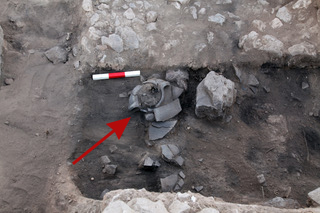
|
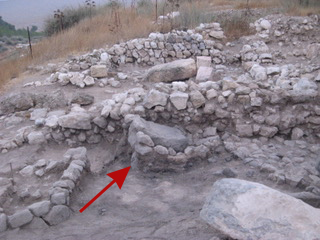
|
General Environment: Beyond Farms and Herds
Archaeology also contributes to our understanding of the general environment in which the ancient Israelites lived. Pollen, coming from archaeological levels, serves as witness for the types of flora present in ancient times. Some of these were cultivated by the ancient farmers, but others grew wild.
The same is true of animal bones from wild animals. Some animals, such as gazelles, were used for food; the story of Jacob and Esau mentions hunting as a supplementary source of food, and the recovery of wild animal bones in domestic context demonstrates that this was in fact the case. Other animals, such as rodents, foxes, hedgehogs, etc., simply died in the vicinity. We also find the remains of work animals, such as donkeys, and even pets; yes, the ancient Israelites had cats and dogs.
Some surprisingly useful data about the ancient environment comes from the remains of land snails retrieved from different strata, as they can help us reconstruct ancient climate prevalent in various periods: Certain conditions are more favorable to certain kinds of snails.
In short, archaeology brings the realia of the text to life. It provides physical witness to the verbal description and fills in the gaps that the text left open. It helps us see what life was like for the majority of the Israelite/Judahite population that did not live in the major cities and formed the basis of biblical society.
TheTorah.com is a 501(c)(3) nonprofit organization.
We rely on the support of readers like you. Please support us.
Published
November 8, 2019
|
Last Updated
December 25, 2025
Previous in the Series
Next in the Series
Before you continue...
Thank you to all our readers who offered their year-end support.
Please help TheTorah.com get off to a strong start in 2025.
Footnotes

Prof. Oded Borowski is Professor (Emeritus) of Biblical Archaeology and Hebrew at Emory University. He is the director of the Lahav Research Project, Phase IV, and of the excavations at Tel Halif. Borowski holds an M.A. and Ph.D. from the University of Michigan, and is a member of the board of trustees of the W.F. Albright Institute for Archaeological Research (AIAR) in Jerusalem. Among his many publications are Agriculture in Iron Age Israel (1987), Every Living Thing: Daily Use of Animals in Ancient Israel (1998), Daily Life in Biblical Times (2003), and Lahav III: The Iron Age II Cemetery at Tell Halif, Site 72 (2013).
Essays on Related Topics:









